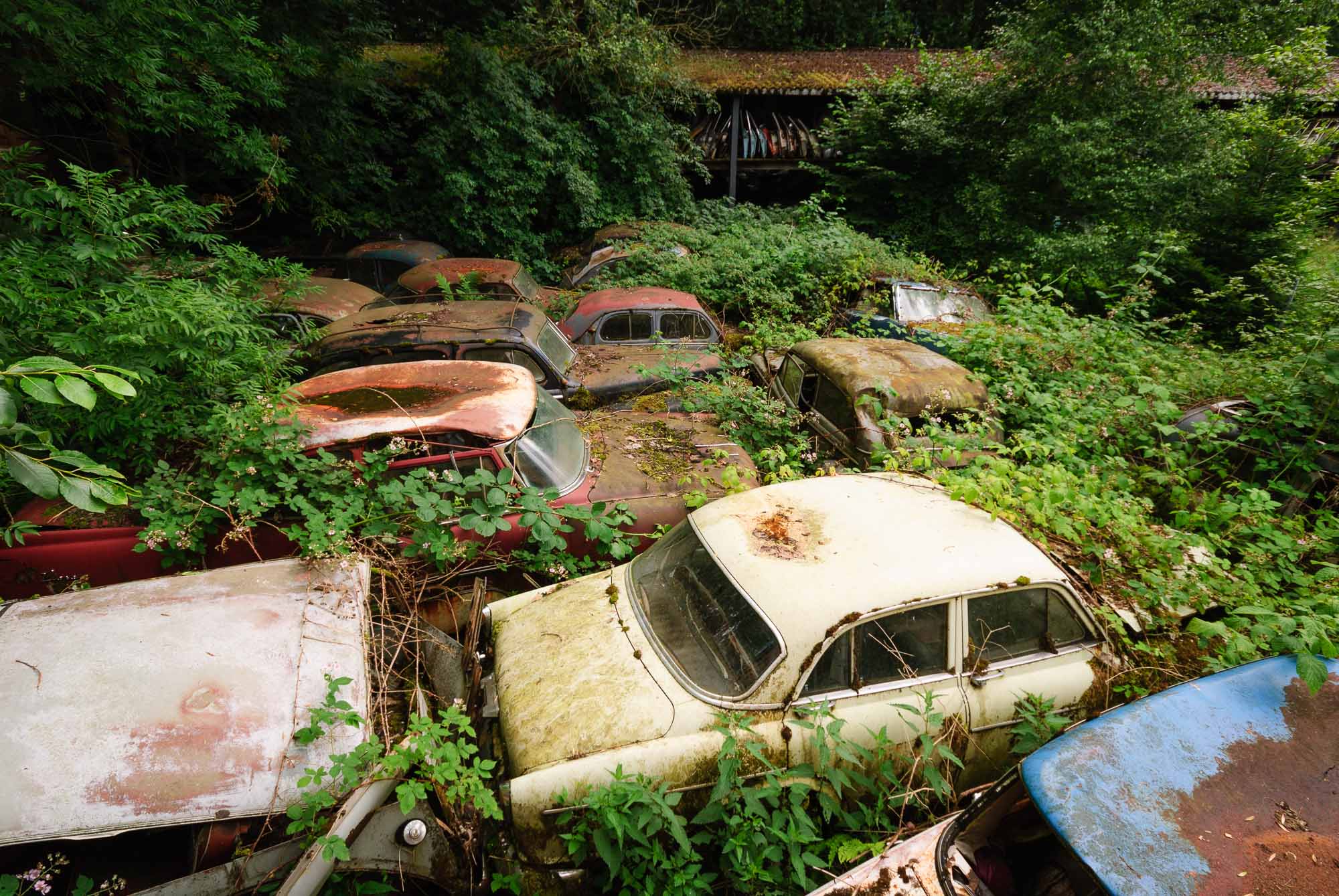I was neither the first, nor the last, photographer to visit the car cemetery in Kaufdorf, a typical Swiss lowland village near Bern, when I shot these photographs amongst the hulk of rotting cars from the past seventy years. Even then, in 2008, there were many questions over how much longer the area would remain: 782 wrecked and rotting cars fading ever so slowly into the surrounding forest. Sad news comes today for the family and fans of the “Autofriedhof”: the site must be cleared. Here’s an article about the closure, which I’ve translated from the German article at the Swiss newspaper “Tagesanzeiger“. (Some parts of the translation and grammar may sound odd, as I’ve translated the piece as closely as I can.)
—
“It’s a shitty feeling. Absolutely.“
Franz Messerli has to close the last resting place for car bodies, which he and his parents created. He wants to hand over the unique location to travellers.
“No-one can help. That’s the worst of it.” Despair is the first thing to leave Franz Messerli’s lips, because no-one can save the overgrown trailer park to the south of Bern. Since 1933, the year when Germany voted for Adolf Hitler, cars have been rotting away in front of him. But now, the eerie yet romantic piece of automotive history must leave the Gürbetal valley. For ever. After much to-ing and fro-ing. That’s what the local authorities want. That’s what the federal courts have decided. And Franz Messerli, trained mechanic, ex-hobby racing driver, breaker, whose business was ruined by the internet, traditionalist, 68 years old, oddball, some say bellyacher; Franz Messerli, a man with many attributes, talks like someone who has experienced a great loss which he wants to explain… but cannot. The 782 classic vehicles, none of them roadworthy, many of them rusty, are being auctioned off on 19th September. With the major auction, which some see as a shameful sign of laziness and which two generations of the Messerli family see as a cult site and the life’s work of Franz and his family, will disappear.
Absolutely the saddest thing
Messerli Jr., already in his 60s, explains “the saddest thing” with an analogy. “The Federational Festival was re-located to Bubendorf in 2002 because of a protected corn snail.” Yet within his car cemetery, biologists have counted 151 types of grass. Birds nest in exhaust pipes, bats flutter through the dusk, spiders’ webs wait during the last days of the eternal place of rest for visitors who each pay Fr. 20 admission. The crazy part of it is that none of the plants and none of the animals are on the red list of protected species. From an official point of view, the mouldering cars are a danger to the environment, not under environmental protection. The authorities are fearful of seeping poisons. “Rubbish“, says Franz Messerli. The cars have been drained.
“A Messerli isn’t a saint“, says Messerli. “He always creates enemies for himself, because he says what he thinks.” The inherited family motto is “who isn’t for me, is against me”. His mother’s correspondence with the authorities (“she was always seen as the nasty woman“) could easily fill ten folders, says her son. Of all things, a brother-in-law was the first to start a movement in the 1960s against a car cemetery in his community.
Almost a Renault factory instead of a cemetery
He wanted to remove what Messerli Sr. created by collecting signatures. The tractor manufacturer Eigenbau – rag and bone men; recycling companies before the word existed – built wood burners into state-conscripted vehicles during the war, so that they ran on pine cones instead of petrol. While he was in service in a military garage, two or three lorries arrived at “Messerli Abbruch GmbH” and interned Russians, Czechs and Poles loaded up all of the working materials. The federal government had seized it. “The robbers in the service of national defence“, as Franz Messerli called them, would pay compensation for the troops billeted at the garage. However, the district clerk embezzled the money. Messerli’s father didn’t go to court; he avoided administrative work, a tendency which his son inherited. Half a dozen certificates of loss in the office window remind him to this day that “goodwill is stupidity“.
The resting place, whose days are now numbered, was created through a quirk of fate. In 1952, Messerli’s father sat down to dinner in the noble restaurant of the Eiffel Tower with Charles Renault. Yellowed photographs show six glasses per guest. Had the pair realised their Parisian plans, a large Renault factory could be standing in Kaufdorf today. But things changedm when Messerli’s father was injured in a speedway race on 20th July 1952. He could only work part time, and Kaufdorf remained a backwater with a car cemetery.
Quarrelling with the authorities – for 34 years
Son Franz joined the business after travelling around the world with hair three times longer than it is today. Behind the garage, he organized evening races with half-dead cars. Whoever wanted to join in, could. “That was totally criminal“, says Messerli Jr., “but luckily, nothing happened“. He, too, has fought with the local authorities “since 1975 non-stop, up to the current day“. And beyond. He will soon be in court for “disobeying an official order” after relaxing in Thailand instead of clearing up at home. Messerli is toying with the idea – or rather threatening – to turn the cleared land over to travellers, who are also affected by the authority’s arbritary decision. As a farewell, he says “It’s a shitty feeling. Absolutely.“:


Leave a Reply